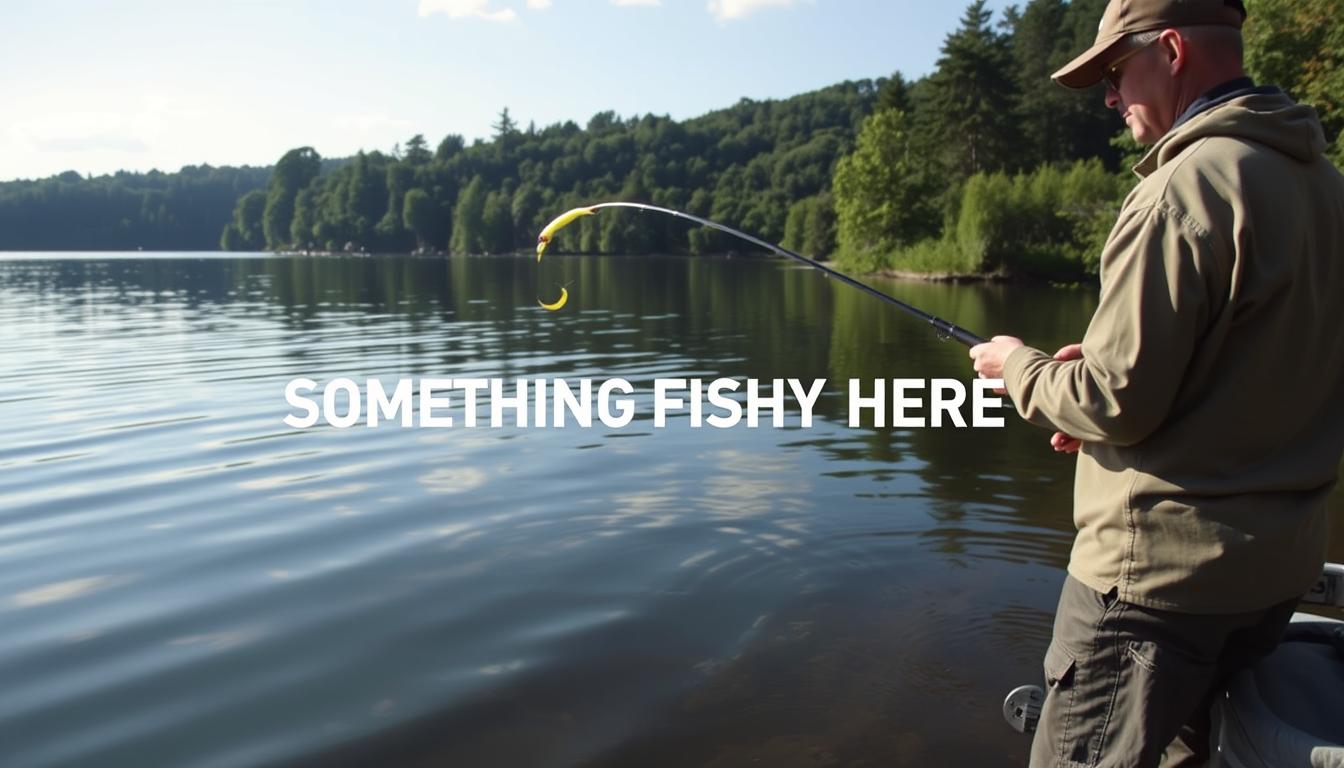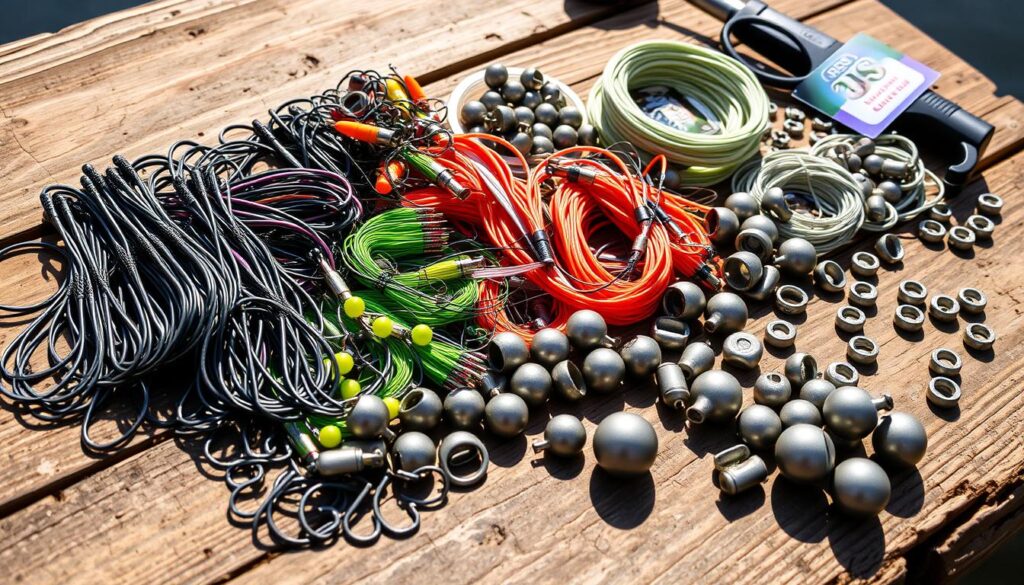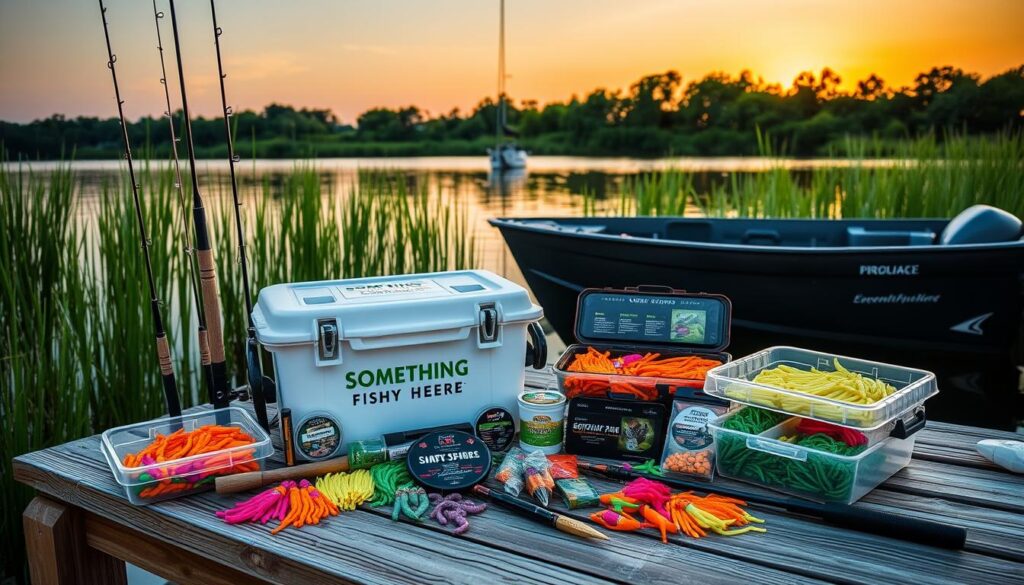Physical Address
304 North Cardinal St.
Dorchester Center, MA 02124
Physical Address
304 North Cardinal St.
Dorchester Center, MA 02124

Bass fishing with plastic worms is a favorite among anglers. It works well in ponds, lakes, and rivers. To catch bass, you need to know the best techniques and choose the right worms.
When you start fishing, pick the right color and rigging method. There are many ways to fish with plastic worms, like Texas rigs and drop shots. Learning these can help you catch more bass.
Bass fishing is a thrilling activity loved by many in North America. People ask why it’s so popular. One reason is that bass can be found in almost every freshwater spot, making it easy to fish.
Plastic worms are a favorite among anglers. They are simple yet effective. Anglers can use them in many ways, like Texas rigging, Carolina rigging, and wacky rigging. This makes them very versatile.
Plastic worms are popular for several reasons. They attract bass with their slow fall and subtle movements. Even in tough conditions, they catch bass well. This makes them a must-have in many tackle boxes.
The fishing community loves plastic worms. Legends say they’ve won many tournaments. Today, manufacturers keep making them better, adding features that make them even more appealing. Their long history and ongoing demand show how important they are in bass fishing.
Plastic worms are key in bass fishing, with many types for different situations. The types of plastic worms vary in length, thickness, and tail design. These features greatly affect how well they attract bass.
There are several characteristics of plastic worms like straight tail, ribbontail, and stick baits. Each type moves differently in water, making them good for different times and places. Straight tail worms move smoothly, while ribbontail worms have a more dramatic action. This can really get bass interested when they’re hungry.
Knowing how to rig plastic worms is important to get the most out of them. Methods like Texas and Carolina rigs hide the hook but still let the worm move naturally. The Texas rig works well in thick weeds, while the Carolina rig is better in deeper or open areas. This makes plastic worms versatile for many fishing spots.
Choosing the right plastic worms for bass fishing can be tough. Many top brands offer different strengths for various fishing needs. For example, the Berkley Gulp! Floating Pinched Crawler looks natural and has a garlic scent to attract bass.
The Gary Yamamoto Senko Worm comes in 25 colors and sizes from 3 to 5 inches. It’s great for casting near structures. The Zoom Ol’ Monster is also popular, especially in early summer ledge fishing, thanks to its big ribbon-tail.
The Zoom Mag II worm is perfect for late summer cover fishing. It’s smaller, which can be very effective. For finesse fishing, the Zoom Trick Worm in 7-inch size is versatile, available in 13 colors.
The Strike King KVD Finesse Worm has a salt-impregnated body to improve hook sets. For durability, the Roboworm’s Straight Tails are a good choice, available in 4.5, 6, and 7 inches.
Many brands offer worms in sizes from 3 to 10 inches. Larger worms attract bigger bass, while smaller ones are better in crowded waters. With over 150 color options, picking the right color can greatly improve your success.
Knowing what each brand offers can help you catch more bass. Whether you need a big worm or a small one, there’s a wide range of options to suit your fishing style.

Getting ready for a bass fishing trip means having the right gear. Choosing the best rod and reel for bass fishing is key. They should match the fishing conditions, giving you the tools to handle different fishing situations. Quality gear helps anglers catch more bass.
A medium to heavy-action rod is best for bass fishing. It works well with spinning or baitcasting reels. This setup gives you better control over your lures.
For fishing in dense vegetation, a heavy-action rod with a spinning reel costs about $200. Medium-action rods for open waters are around $150. Baitcasting reels, especially those with 10-11 lbs. of drag, cost about $150 for fishing in weeds or lily pads. Always choose braided line for better sensitivity and performance.
Polarized sunglasses are a must for bass fishing. They cut down water glare, helping you see underwater structures and avoid scaring fish. Prices range from $5 for basic frames to over $250 for high-end models.
Good polarized sunglasses improve your chances of spotting fish and understanding their behavior. Also, consider a UV performance fishing shirt for about $25. It keeps you cool and protected from the sun.

| Item | Average Cost | Notes |
|---|---|---|
| Medium to Heavy Action Rod | $150 – $200 | Best for dense vegetation or open waters. |
| Baitcasting Reel | $150 | Ideal for controlled fishing with strong drag. |
| Polarized Sunglasses | $5 – $250 | Reduces glare and enhances visibility of fish. |
| UV Performance Fishing Shirt | $25 | Provides sun protection and aids in sweat evaporation. |
Exploring different plastic worm fishing techniques is key for any angler. Each method has its own benefits. This lets fishermen adjust their tactics based on the situation and how fish behave.
The Texas rig is a favorite for fishing with plastic worms. It’s great for fishing in heavy cover because it’s weedless. Anglers use Texas rig plastic worms to get through areas with lots of structure.
The setup is simple. The hook goes through the worm’s head. This lets the worm swim naturally in the water.
The Carolina rig is known for its versatility. It started in South Carolina and became famous after a Bass Master win in 1991. This method is good because it keeps the bait above the bottom.
It attracts bass that might not be looking to eat. Anglers often use floating baits with this rig to make it even better.
The wacky rig is a finesse fishing method. It’s especially good when bass are not very active. This technique involves piercing the worm in the middle.

This lets the worm hang with the hook point up. As it falls, its natural movement can attract fish. It’s a top choice for catching fish that are hard to get.
| Technique | Description | Best Use |
|---|---|---|
| Texas Rig | Weedless presentation ideal for heavy cover | Fishing in thick vegetation |
| Carolina Rig | Floating bait stays above the bottom | Attracts inactive bass and fishes deeper |
| Wacky Rig | Hook pointed exposed for natural action | Effective when bass are less active |
Choosing the right color for plastic worms is key to catching bass. Colors like black, green pumpkin, junebug, pumpkinseed, watermelon, and blue work well. Each color is best in different water conditions. For example, green pumpkin and watermelon are great in clear water, while black and purple work better in murky water.
Tom Mann, the founder of Mann’s Bait, suggested black worms in the 1970s. This idea became popular among anglers. Bill Dance also recommended blue worms, adding to the list of colors to try. It’s important to experiment to find what works best for you.
Berkley advises trying different colors to see what bass like. You can also dye worms for brighter tails or unique colors. This can be especially helpful in areas where many fisherman fish.
The table below shows common plastic worm colors, how well they work, and the best water conditions for them:
| Color | Effectiveness | Recommended Conditions |
|---|---|---|
| Black | High | Murky/Low Light |
| Green Pumpkin | High | Clear |
| Watermelon | High | Clear |
| Junebug | Moderate | Murky |
| Blue | Moderate | Varied |
| Black Grape | High | Murky/Low Light |
| Bama Bug | High | Varied |
Knowing the fishing spot is key to success with plastic worms. Each place needs its own special way to fish. Here’s how to do well in ponds, lakes, and rivers.
In ponds, fishing is all about finding the right spots. Look for underwater rocks, fallen trees, or thick plants where bass like to hide. A slow move of the worm is best here, as it looks like real prey.
Using a Texas rig is smart in these places. It lets you get the worm close to bass without getting stuck on underwater stuff.
Lakes are different, with many places to fish. For deep spots, use heavy weights to get your bait to the bottom. Bass like to hang out there.
Don’t forget to fish both shallow and deep areas. Bass can be at different depths depending on the season. A Carolina rig is good for covering more ground and attracting bass.
In rivers, knowing the current is important. Bass hide in spots where the current is slower, like eddies and seams. Fishing upstream helps avoid getting stuck, and the current makes your worm move naturally.
Knowing how bass behave is key for any good angler. Factors affecting bass feeding include the season, water temperature, and how clear the water is. Grasping these details can make your fishing trips better.
Bass rely a lot on what they see. They like to hide in places like underwater trees or rock piles to catch their prey. This habit changes with the seasons. For example, in spring, bass move to shallower waters to spawn and eat a lot of baitfish.
In summer, bass spread out in the lake. They look for cool, shaded spots. This is because they need to stay cool in the warmer months.
Each season brings its own patterns in bass fishing. In fall, bass focus on eating a lot to gain weight before winter. Winter bass prefer warmer, deeper water with plenty of oxygen. They move slowly at this time, so anglers need to fish slowly and use bigger lures.

To catch bass better in winter, try using soft plastics and trick worms. Some good ways to fish for these slow-moving bass include:
Knowing how bass act in different seasons helps a lot. By changing your fishing style and gear, you can catch more fish.
| Season | Bass Behavior | Best Techniques |
|---|---|---|
| Spring | Migrating to shallows, aggressive feeding | Texas Rig, Wacky Rig |
| Summer | Spreading to deeper, shaded areas | Drop-shotting, Carolina Rig |
| Fall | Feeding heavily on baitfish | Topwater lures, Jigging |
| Winter | Preferring warm, deep water; lethargic | Slow presentations, larger baits |
Seasonal bass fishing brings unique challenges and exciting opportunities. Knowing how to use plastic worms in different seasons can greatly improve your success. Each season changes bass behavior, so you need to adjust your techniques for the best results.
In spring, bass move shallow to spawn. A weedless Texas rig is key. Use a 3/8-ounce or 1/2-ounce weight with a 5/0 or 6/0 VMC Worm Hook for effective presentations near spawning beds. Summer brings bass to deeper waters. Use the Zoom Ol’ Monster with a 12-pound Sufix Fluorocarbon line. Adjust weights for depth, using a 14 to 17-pound line for the Zoom Mag II worm in deep cover.
Fall makes bass more aggressive, offering diverse approaches with plastic worms. Try the shaky head and drop shot rigs with Zoom Swamp Crawler and Magnum Swamp Crawler. These methods tap into the bass’s heightened feeding instinct. Winter fishing requires finesse. Use lighter lines and subtle movements, like wacky rig presentations with finesse worms, to entice lethargic bass.
| Season | Techniques | Recommended Gear |
|---|---|---|
| Spring | Weedless Texas Rig | 3/8 or 1/2-ounce weight; 5/0 or 6/0 VMC hook |
| Summer | Zoom Ol’ Monster Fishing | 12-pound Sufix Fluorocarbon line; 14 to 17-pound line for deep cover |
| Fall | Shaky Head, Drop Shot | Zoom Swamp Crawler; Magnum Swamp Crawler |
| Winter | Finesse Techniques | Light lines; Wacky rigs with finesse worms |
Understanding seasonal changes helps you adapt techniques for success. Mastering these conditions enhances your bass fishing experience. It encourages exploring different plastic worm presentations all year.
Start your step-by-step guide for bass fishing by picking the right spot. Look at the season and water conditions to find where bass like to be. In spring and summer, warmer shallows are good. But in fall and winter, deeper waters are better.
Get your gear ready with a 7 ft heavy-action rod and 12-17 lb test line. Use 3/0 offset-shank hooks and 0.062–0.75 oz bullet sinkers. This setup helps your bait work best.
Choose your bait color based on how clear the water is. Dark colors like purple or brown work well in murky water. Brighter colors are better in clear water to make your bait stand out. This small change can really help when using plastic worms effectively.
Look for structures like points, drop-offs, or submerged plants. Use slow retrieves with pauses to look like a natural bait. This method, along with a good presentation, boosts your chances of catching bass.
Use these strategies and enjoy catching bass with plastic worms. Adjusting to conditions and watching bass behavior can make your fishing better.
Using the right plastic worm fishing tips can make your fishing trip better and increase your chances of catching bass. Try different worm sizes and colors to see what works best. Remember, patience is key. Pauses during your retrieve can often trigger bites.
Using structures like logs or rocks can also help. These spots make it easier for bass to strike.
Choosing the right tackle is important for bass fishing. Larry Nixon suggests using an unpegged sinker for plastic worms. This helps prevent losing fish and improves hook settings.
There are different hooks to choose from. A straight shank hook keeps the worm’s action natural. A thin wire flipping hook helps it penetrate better.
The way your worm falls can also affect your success. Adjust your weight based on water clarity and bass behavior. Nixon prefers a 7-foot, medium-heavy Dobyns Champion Extreme Casting Rod for better bite detection.
Keeping your line in good condition is important. Stretch fluorocarbon line to prevent coiling. Wet knots before tightening them. Avoid over-spooling your reel.
Nixon recommends a hopping technique over simple dragging. Try the hop-twice-and-move-on method for better fishing patterns.
Choose eco-friendly sinkers like tungsten or steel instead of lead. Scented plastic worms can also attract bass. With patience and practice, these tips can lead to a great fishing day.

Bass fishing with plastic worms is a top choice for many anglers. It’s known for its effectiveness in catching bass. By learning different rigging methods and choosing the right gear, you can boost your chances of success.
Understanding soft plastic materials is key to improving your fishing. Knowing the differences between types like Z-Man’s ElaZtech and Deps Cover Scat helps you pick the best bait. This knowledge can make your fishing trips more productive.
Choosing well-known brands like Yamamoto Senko or Zoom Super Fluke can also help. These brands offer proven baits that work well in different conditions. Using these baits can make your fishing more enjoyable and successful.